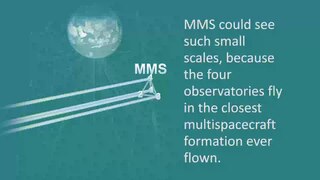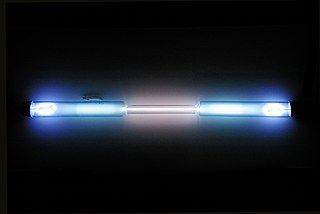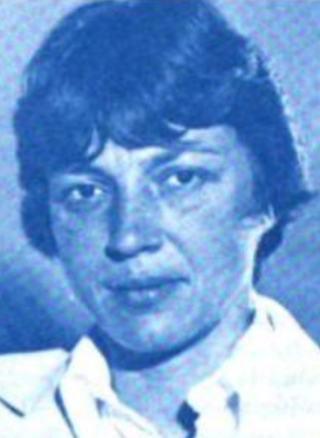This is a list of plasma physics topics.

Argon is a chemical element with the symbol Ar and atomic number 18. It is in group 18 of the periodic table and is a noble gas. Argon is the third-most abundant gas in Earth's atmosphere, at 0.934%. It is more than twice as abundant as water vapor, 23 times as abundant as carbon dioxide, and more than 500 times as abundant as neon. Argon is the most abundant noble gas in Earth's crust, comprising 0.00015% of the crust.

Xenon is a chemical element with the symbol Xe and atomic number 54. It is a dense, colorless, odorless noble gas found in Earth's atmosphere in trace amounts. Although generally unreactive, it can undergo a few chemical reactions such as the formation of xenon hexafluoroplatinate, the first noble gas compound to be synthesized.

In plasma physics, an Alfvén wave, named after Hannes Alfvén, is a type of plasma wave in which ions oscillate in response to a restoring force provided by an effective tension on the magnetic field lines.
Berkelium (97Bk) is an artificial element, and thus a standard atomic weight cannot be given. Like all artificial elements, it has no stable isotopes. The first isotope to be synthesized was 243Bk in 1949. There are 20 known radioisotopes, from 230Bk and 233Bk to 253Bk, and 6 nuclear isomers. The longest-lived isotope is 247Bk with a half-life of 1,380 years.
Fermium (100Fm) is a synthetic element, and thus a standard atomic weight cannot be given. Like all artificial elements, it has no stable isotopes. The first isotope to be discovered was 255Fm in 1952. 250Fm was independently synthesized shortly after the discovery of 255Fm. There are 20 known radioisotopes ranging in atomic mass from 241Fm to 260Fm, and 4 nuclear isomers, 247mFm, 250mFm, 251mFm, and 253mFm. The longest-lived isotope is 257Fm with a half-life of 100.5 days, and the longest-lived isomer is 247mFm with a half-life of 5.1 seconds.
Californium (98Cf) is an artificial element, and thus a standard atomic weight cannot be given. Like all artificial elements, it has no stable isotopes. The first isotope to be synthesized was 245Cf in 1950. There are 20 known radioisotopes ranging from 237Cf to 256Cf and one nuclear isomer, 249mCf. The longest-lived isotope is 251Cf with a half-life of 898 years.
Mendelevium (101Md) is a synthetic element, and thus a standard atomic weight cannot be given. Like all artificial elements, it has no stable isotopes. The first isotope to be synthesized was 256Md in 1955. There are 17 known radioisotopes, ranging in atomic mass from 244Md to 260Md, and 5 isomers. The longest-lived isotope is 258Md with a half-life of 51.3 days, and the longest-lived isomer is 258mMd with a half-life of 57 minutes.
Lawrencium (103Lr) is a synthetic element, and thus a standard atomic weight cannot be given. Like all synthetic elements, it has no stable isotopes. The first isotope to be synthesized was 258Lr in 1961. There are fourteen known isotopes from 251Lr to 266Lr, and seven isomers. The longest-lived known isotope is 266Lr with a half-life of 11 hours.

Krypton is a chemical element with the symbol Kr and atomic number 36. It is a colorless, odorless, tasteless noble gas that occurs in trace amounts in the atmosphere and is often used with other rare gases in fluorescent lamps. Krypton is chemically inert.
A double layer is a structure in a plasma consisting of two parallel layers of opposite electrical charge. The sheets of charge, which are not necessarily planar, produce localised excursions of electric potential, resulting in a relatively strong electric field between the layers and weaker but more extensive compensating fields outside, which restore the global potential. Ions and electrons within the double layer are accelerated, decelerated, or deflected by the electric field, depending on their direction of motion.

Quark–gluon plasma is an interacting localized assembly of quarks and gluons at thermal and chemical (abundance) equilibrium. The word plasma signals that free color charges are allowed. In a 1987 summary, Léon van Hove pointed out the equivalence of the three terms: quark gluon plasma, quark matter and a new state of matter. Since the temperature is above the Hagedorn temperature—and thus above the scale of light u,d-quark mass—the pressure exhibits the relativistic Stefan-Boltzmann format governed by temperature to the fourth power and many practically massless quark and gluon constituents. It can be said that QGP emerges to be the new phase of strongly interacting matter which manifests its physical properties in terms of nearly free dynamics of practically massless gluons and quarks. Both quarks and gluons must be present in conditions near chemical (yield) equilibrium with their colour charge open for a new state of matter to be referred to as QGP.

Plasma is one of four fundamental states of matter, characterized by the presence of a significant portion of charged particles in any combination of ions or electrons. It is the most abundant form of ordinary matter in the universe, mostly in stars, but also dominating the rarefied intracluster medium and intergalactic medium. Plasma can be artificially generated by heating a neutral gas or subjecting it to a strong electromagnetic field.

A ball-pen probe is a modified Langmuir probe used to measure the plasma potential in magnetized plasmas. The ball-pen probe balances the electron and ion saturation currents, so that its floating potential is equal to the plasma potential. Because electrons have a much smaller gyroradius than ions, a moving ceramic shield can be used to screen off an adjustable part of the electron current from the probe collector.

Sir Steven Charles Cowley is a British theoretical physicist and international authority on nuclear fusion and astrophysical plasmas. He has served as director of the United States Department of Energy (DOE) Princeton Plasma Physics Laboratory (PPPL) since 1 July 2018. Previously he served as president of Corpus Christi College, Oxford, since October 2016. and head of the EURATOM / CCFE Fusion Association and chief executive officer of the United Kingdom Atomic Energy Authority (UKAEA).

Leopoldo Soto Norambuena is a Chilean Physicist born in Santiago, Chile, on October 14, 1964. His publication appears with the name Leopoldo Soto or L. Soto. He works at the Comisión Chilena de Energía Nuclear where he founded the Plasma Physics and Nuclear Fusion Laboratory. His main contributions are in experimental physics. The group that he created and leads is a pioneer in the miniaturization of dense plasma focus devices which can reproduce, on a scale basis, similar physics as the ones obtained in large devices which are only available in large laboratories of the world. Due to Soto's contributions, it is possible to develop relevant research in dense transient plasmas using small devices.

Emanuele Quercigh is an Italian particle physicist who works since 1964 at CERN, most known for the discovery of quark-gluon plasma (QGP). Quercigh moved as a child to Friuli with his mother and his younger brother after the early death of his father. Quercigh studied physics at the University of Milan in Italy, where he became assistant of professor Giuseppe Occhialini in 1959.
Solar radio emission refers to radio waves that are naturally produced by the Sun, primarily from the lower and upper layers of the atmosphere called the chromosphere and corona, respectively. The Sun produces radio emissions through four known mechanisms, each of which operates primarily by converting the energy of moving electrons into electromagnetic radiation. The four emission mechanisms are thermal bremsstrahlung (braking) emission, gyromagnetic emission, plasma emission, and electron-cyclotron maser emission. The first two are incoherent mechanisms, which means that they are the summation of radiation generated independently by many individual particles. These mechanisms are primarily responsible for the persistent "background" emissions that slowly vary as structures in the atmosphere evolve. The latter two processes are coherent mechanisms, which refers to special cases where radiation is efficiently produced at a particular set of frequencies. Coherent mechanisms can produce much larger brightness temperatures (intensities) and are primarily responsible for the intense spikes of radiation called solar radio bursts, which are byproducts of the same processes that lead to other forms of solar activity like solar flares and coronal mass ejections.

Ambrogio Fasoli is a researcher and professor working in the field of fusion and plasma physics. A Fellow of the American Physical Society, he is Director of the Swiss Plasma Center, located at EPFL, the Swiss Federal Institute of Technology in Lausanne, Switzerland. Since 1 January 2019, he chairs the European consortium EUROfusion, the umbrella organisation for the development of nuclear fusion power in Europe.

Dianne Kasnic Prinz was an American scientist, a physicist with the United States Naval Research Laboratory. She trained as an astronaut, and was mission communicator for STS-51-F.

The Tokamak Chauffage Alfvén Brésilien (TCABR) is a tokamak situated at the University of Sao Paulo (USP), Brazil. TCABR is the largest tokamak in the southern hemisphere and one of the magnetic-confinement devices committed to advancing scientific knowledge in fusion power.